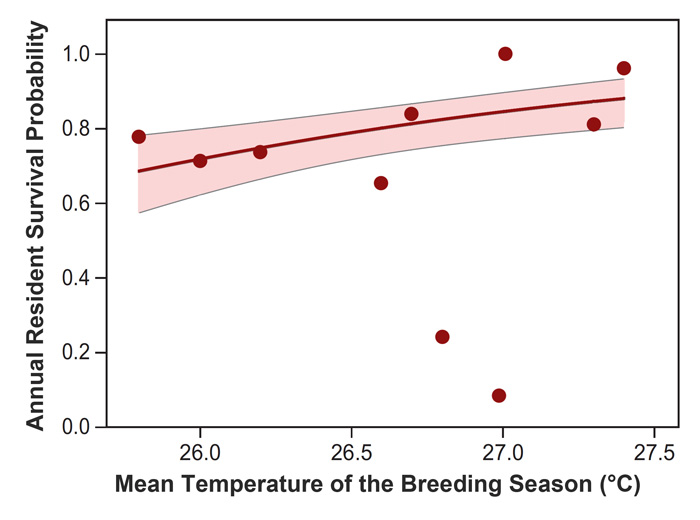| Follow @co2science |
Paper Reviewed
Jansen, D.Y.M., Wilson, A.M. and Altwegg, R. 2015. Climatic influences on survival of migratory African Reed Warblers Acrocephalus baeticatus in South Africa. Ardea 103: 163-174.
In this intriguing study of a bird species found in the Southern Hemisphere -- Acrocephalus baeticatus (more commonly known as the African Reed Warbler) -- Jansen et al. (2015) used temperature and rainfall data in its breeding area plus Normalized Difference Vegetation Index (NDVI) data in its wintering area (Central Africa around the Congo Basin) to compare against the results of capture-mark-recapture models of survival for open populations of the species over the period 1998-2010. And what did they learn from this exercise?
The three researchers report that of the three factors they studied, "rainfall and NDVI did not influence survival." However, they discovered that "mean temperature (Aug-Apr) had a positive effect on survival" (see figure below), noting that an increase of 1.6°C was associated with an increase in annual survival probability that rose from 0.69 ± 0.05 to 0.88 ± 0.03."

Survival of adult African Reed Warblers in relation to temperature (Aug-Apr) in Central Africa (1999-2010). Adapted from Jansen et al. (2015).
As for how this could be, they suggest that "higher temperatures could have increased local survival by providing more food and breeding habitat, thereby increasing adult body condition and reducing foraging costs, predation and territorial conflicts." And they thus -- and with great confidence -- declared their discovery of "a clear effect of climatic variation on a key demographic parameter, adult survival," further noting that "the mean temperature (Aug-Apr) in the breeding area was the only single variable that was significantly correlated with survival in this species."
In terms of the mechanics of the phenomenon -- and in further discussion of their findings -- Jansen et al. suggest that the documented temperature rise led to increased food availability that reduced foraging costs and led to a proliferation of reeds that expanded the warblers' breeding habitat, thereby reducing territorial disputes and deceasing predation risk in denser and higher reeds," while also citing in this regard the prior studies of Urban et al. (1997), Eising et al. (2001) and Leisler and Schulte-Hagen (2011).
And so we see -- as in the old Marilyn Monroe movie -- even in the case of birds, some like it hot!
References
Eising, C.M., Komdeur, J., Buys, J., Reemer, M. and Richardson, D.S. 2001. Islands in a desert: breeding ecology of the African Reed Warbler Acrocephalus baeticatus in Namibia. Ibis 43: 482-493.
Leisler, B. and Schultze-Hagen, K. 2011. The Reed Warblers. Diversity in a Uniform Bird Family. KNNV Publishing, Zeist.
Urban, E.K., Fry, C.H. and Keith, S. 1997. The Birds of Africa. Vol. 5, Academic Press, London, UK.
Posted 22 June 2016



